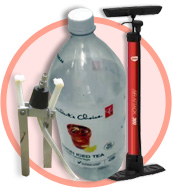Designing and Building Water Rockets
Overview
 Students design and test water rockets made from recyclable plastic bottles. Students are encouraged to prototype and experiment with aerodynamics by creating fins and tops for their rockets.
Students design and test water rockets made from recyclable plastic bottles. Students are encouraged to prototype and experiment with aerodynamics by creating fins and tops for their rockets.
Rationale (Why we are doing this?)
When students explore with design and prototyping, powerful learning occurs. This project has numerous applications with propulsion, extreme frontiers, exploration, and forces and energy.
Materials/Resources
- Water rocket launcher (available through a number of sources – see pictures)
- Pop bottle ( 1 or 2 litre)
- Water source (hose or bucket of water)
- Masking tape (electrician’s tape is helpful)
- Recycled cardboard, Bristol board
Context and Background Knowledge
Students will need to have a very basic background with scissors and tape. It also helps to give a students a chance to see rocket design/features. This can be done through pictures, video, class discussions, etc. This can be made more complex when student start to compare actual rocket parts to the correlating parts of the their water rocket.
Curricular Connections (Competencies and Content)
| Do research to understand the background of the design issue | (ADST-4) |
| Do research to understand the background of the design issue | (ADST-4) |
| Identify a design issues | (ADST-4) |
| Identify key features or user requirements | (ADST-4) |
| Generate potential ideas | (ADST-4) |
| Gather peer feedback and inspiration | (ADST-4) |
| Co-operatively design projects | (Science-4) |
| Transfer and apply learning to new situations | (Science-4) |
| Generate and introduce new or refined ideas when problem solving | (Science-4) |
| Make simple inferences based on their results and prior knowledge | (Science-4) |
| the effect of temperature on pressure in a gas | (Science-4) |
| the effect of temperature on pressure in a gas | (Science-5) |
Explore + Understand + Create (Key elements/Lesson Design/Format)
- Have students look at pictures and video clips of rockets and decide what elements all rockets seem to have. Show a few images of water rocket and discuss parallel elements.
- On paper, have students work singly or groups of two (collaboratively) to draw a design concept.
- Provide time and materials to design and build rockets. Encourage discussion and the sharing of ideas.
- Launch and test rockets.
- It is important for students to get a second chance to alter the design and adjust based on what they observed. This prototype, test, re-evaluate, test process is important to scientific and applied learning.
Applications/Adaptations/Extensions
- Students make a paper altimeter and graph results and trials
- Test different size/shape of water bottles
- Build corresponding elements to a real rocket and have a parachute deliver the “pay-load” back to earth safely.
Special Notes
Please be aware of safety elements when doing this. There is potential for a rocket to hit someone’s face. Rockets can generate force and the observing from a safe distance is important. Students and staff that are launching were wearing hockey masks. Consider using safety glasses as an alternative and have the class observe from a safe distance (20 meters) that allows mass and velocity to be reduced.
